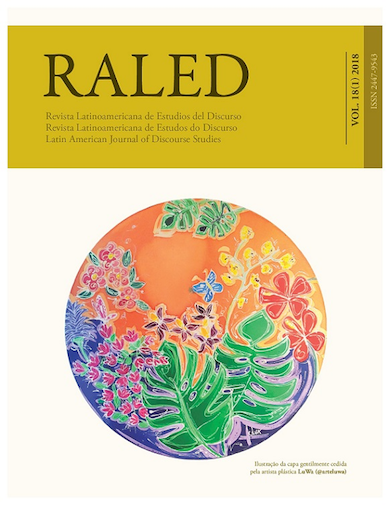Effects of meanings in the chapter of the Brazilian telenovela “Velho Chico”
DOI:
https://doi.org/10.35956/v.18.n1.2018.p.61-78Keywords:
discursive genre. identity. interdiscourse. effectsofsense.Abstract
This work is based on the theory of Discourse Analysis of French matrix. Visa (des) build the image of the black carácter on the scene of the Brazilian television set “Velho Chico”. For the production of the image of black people, we dialogue with the historical-cultural, mediatic and ideological contexts that refer to the images that society produces in relation to ethnic racial issues in discourse. We intend to interpret the performance of the black characters in the telenovela. The work of Courtine (1994), Munanga (2005), Orlandi (2001), has been used as a theoretical basis for research of na interpretative and qualitative nature, the corpus is constituted in chapter ninety-four of the telenovela “Velho Chico” (“Old River”). Red (2005) and Dias (2011). We conclude that these discourses bring to the surface a discursive memory, addressed to black people. The telenovela contributed to the discussion about the identity, the sayings produced different effects of senses to the public that watches the telenovela.
Downloads
References
ARAÚJO, J. Z. 2008. O negro na dramaturgia, um caso exemplar da decadência do mito da democracia racial brasileira. Revista Estudos Feministas 16, 3: 979- 985.
BAKHTIN, M.M y VOLOSCHINOV, V.N. 2006. Marxismo e Filosofia da Linguagem: Problemas funda-mentais do método sociológico na ciência da linguagem. São Paulo: Hucitec.
CALZA, R. 1996. O que é telenovela. São Paulo: Brasiliense. CHARAUDEAU, P. 2004. Visadas discursivas, gêneros situacionais e construção textual. Em I. Machado y R. de Mello (orgs.). Gêneros: reflexões em análise do discurso. Núcleo de Análise do Discurso, pp. 13-42. Belo Horizonte: Nad/Fale-UFMG.
CHARAUDEAU, P. 2015. Discurso das mídias. São Paulo: Contexto.
COURTINE, J. J. 1994. Le tissu de la mémoire: quelques perspectives de travail historique dans les sciences du langage. Langages 114: 5-12.
COURTINE, J. J. 1999. O chapéu de Clémentis. Observações sobre a memória e o esquecimento na enunciação do discurso político. Em F. Indursky y M. Ferreira (org.). Os múltiplos territórios da análise do discurso, pp. 221- 236. Porto Alegre: Sagra Luzzato.
DIAS, C. 2011. [Disponível em http://www.labeurb.unicamp.br/livroEurbano/]. e-Urbano: a for-ma material do eletrônico no urbano. Em C. Dias. E-urbano: Sentidos do espaço urbano/digital [online]. Laboratório de Estudos Urbanos LABEURB/Núcleo de Desenvolvimento da Criatividade ”“ NUDECRI, Universidade Estadual de Campinas ”“ UNICAMP.
FERREIRA, E. y ORLANDI, E. 2014. Sociedade do Conhecimento e/ou Sociedade da Informação. Em E. Ferreira y E. Orlandi (orgs). Discursos sobre a inclusão, pp. 148- 152. Niterói: Intertexto.
FOUCAULT, M. 1971. Arqueologia do saber. Petrópolis: Vozes. HALL, S. 2003. Da diáspora: Identidades e mediações culturais. Belo Horizonte: Editora UFMG.
INDURSKY, F. 2001. Da heterogeneidade do discurso à heterogeneidade do texto e suas implicações no processo da leitura. Em A. Ernest-Pereira y S. Bornéo Funck (orgs.). A leitura e a escrita como práticas discursivas, pp. 28-41. Pelotas: Educat.
ORLANDI, E. P. 2011. A Casa e a Rua: uma relação política e social. Educação & Realidade 36, 3: 693-703.
ORLANDI, E. P. 2001. Análise de discurso: princípios e procedimentos. Campinas: Pontes Editores.
ORLANDI, E. P. 2007. Autoria, leitura e efeitos do trabalho simbólico. Campinas: Pontes Editores.
ORLANDI, E. P. 2014. Linguagem, sociedade, políticas. Pouso Alegre: UNIVÁS.
RODNEY, W. 2007. El diseño de un corpus multimodal. Estudios de Lingüística Aplicada 25, 46: 207- 231.
ROJO, R. 2005. Gêneros do discurso e gêneros textuais: questões teóricas e aplicadas. Em J. L. Meurer, A. Bonini y D. Motta-Roth (orgs.). Gêneros: teorias, métodos, debates, pp. 185-207. São Paulo: Parábola.
ROJO, R. 2015. Hipermodernidade, multiletramentos e gêneros discursivos. São Paulo: Parábola Editorial.
SANT’ANA, A. O. 2005. História e conceitos básicos sobre o racismo e seus derivados. Em M. Ka-bengele (org.). Superando o Racismo na escola, pp. 39-67. Brasília: Ministério da Educação, Secretaria de Educação Continuada, Alfabetização e Diversidade.
THIBAULT, P. 2000. The multimodal transcription of a television advertisement: theory and practi-ce. En A. Baldry (ed.). Multimodality and multimediality in the distance learning age, pp. 311-385. Campobasso: Palladino Editore.
WERNECK, J. 2012. [Disponível em: www.editora.vrc.puc-rio.br/media/ebook_outras_mulheres.pdf ]. Prefácio. Em D. Fonseca y T. Marques de Olveira de Lima (orgs.). Outras mulheres: mulheres negras brasileiras ao final da primeira década do século XXI, pp. 7-10. Rio de Janeiro: EdPUC-Rio. [Acesso: 11. De Setembro de 2017].
Downloads
Published
How to Cite
Issue
Section
License

This work is licensed under a Creative Commons Attribution-NonCommercial-NoDerivatives 4.0 International License.
The authors retain the copyright and guarantee RALED the right to be the first publication of the work as well as a Creative Commons Attribution License that allows others to share the work with recognition of authorship and the initial publication in this journal.




